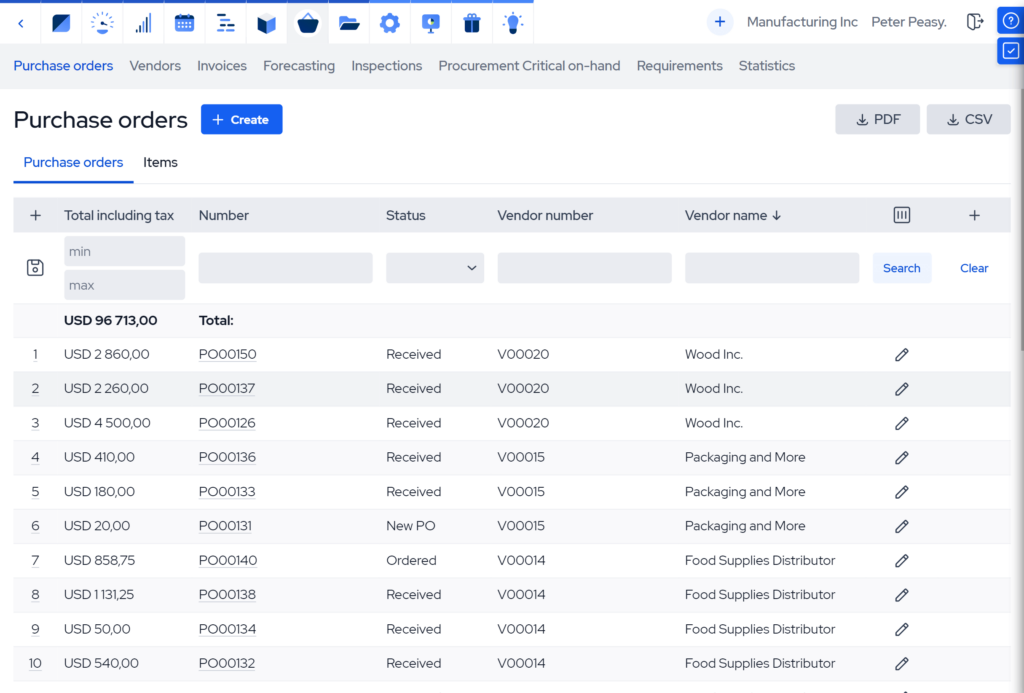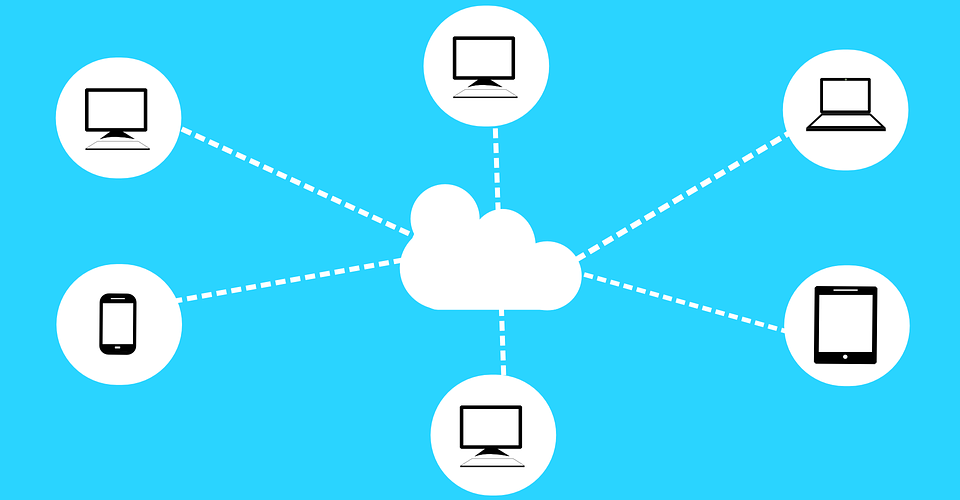Procurement Management – A Quick Guide for Small Manufacturers
Procurement management is more than making phone calls and arranging the purchase of materials. It is a vital part of any manufacturing operation that helps to ensure the right materials are in the right place and at the right time.

What is procurement management?
Procurement management is the process of managing all purchasing-related activities for a company in order to acquire materials at acceptable terms. It is a strategic business process for controlling and managing key aspects of materials acquisition, from planning and sourcing goods and services to vendor management, contracting, and delivery.
Managing procurements is important to ensure high-quality raw materials or services with acceptable lead times and competitive prices and purchase terms. Effective procurement practices further help establish good supplier relationships, mitigate supply risks, and simplify compliance through accurate paper trails and visibility.
A well-functioning procurement team increases the operational efficiency of the whole manufacturing effort by simplifying production planning, ensuring high-quality raw materials, and keeping material costs in check.
So what exactly is procurement, and how is it different from purchasing?
What is procurement?
Procurement is the process of locating, negotiating, and acquiring suitable goods and services from an external source for a company. It’s more than simply buying raw materials or supplies for your business. Procurement refers to all of the processes that satisfy the company’s needs for outsourced goods and services.
Purchasing is a central aspect of procurement, but it’s not the whole picture. It’s preceded by finding suitable suppliers, evaluating their produce, and negotiating terms; and followed by tracking, receiving, and checking the goods for conformity and managing the involved paper trail.
The role of procurement within supply chain management
Procurement is a subset of the larger supply chain management process. Supply chain management encompasses the whole lifecycle of the product, from raw materials acquisition and transit to inventory, production, and shipment to customers, including returns or warranty claims.
In dealing with the first stretch of the product’s supply chain, procurement plays a critical role in supply chain management. It directly influences the efficiency and reliability of the entire chain. By ensuring that high-quality raw materials or components are sourced at optimal costs and delivered on time, procurement acts as the foundation for smooth business operations. Any disruptions or inefficiencies in procurement can cascade through the supply chain, causing delays, increasing costs, impacting product quality and, ultimately, customer satisfaction.
Key steps of the procurement process
Because procurement management involves many processes, smaller companies might find it difficult to keep on top of everything. This is especially true if you do not have a designated procurement team or if the procurement manager’s role is divided between employees with other responsibilities.
Let’s examine the procurement process and its different stages from a manufacturer’s perspective. It’s a good idea to draw up a procurement management plan outlining central procurement processes. Since procurement planning is an important part of your manufacturing business, it should be in close contact with sales, finance, and production planning.
1. Requirements planning
First, what needs to be purchased, when, and in what quantities needs to be determined. This means that finances and production planning must be involved in the procurement process from the start.
Check for required items from your bills of materials to determine what needs to be acquired and in what quantity. Then, consult your production schedule to determine the latest delivery times to ensure you can fulfill work orders on time. Be mindful of the maximum viable cost of purchasing the goods, as the direct material cost of your goods is a major factor in production costing and setting competitive prices.
This will give you ample data about the required items. Depending on the industry, there might be further requirements for materials like conformity and quality standards, certifications, etc. The procurement department’s task is to truncate and provide this data reliably for all outsourced items.
This is possible by talking to the relevant people and documenting the requirements on paper or in spreadsheets. Modern manufacturing software, however, makes material requirements planning far easier by automating large parts of the process and consolidating data between departments.
2. Sourcing
Once the material requirements have been determined, who to buy them from is the topic of sourcing. The goal is simple – find suppliers who can provide the right quantity and quality of goods at competitive prices while meeting your delivery timelines.
Start by researching potential suppliers and consider factors such as their reputation, capacity, reliability, and compliance with industry standards. Consider making an approval workflow, which may involve requesting and evaluating quotes or proposals, comparing terms, and ensuring that the supplier meets your specific requirements like certifications or special handling for certain materials.
Managing supplier relationships is also a key part of sourcing. Establishing long-term partnerships leads to better pricing, prioritizing your orders during high demand, and smoother communication. It’s equally important to diversify your supplier base and segment suppliers to mitigate risks like supply disruptions or price volatility.
Other supply partners like logistics companies or shipping services should also be researched, and their capacity to cooperate with your selected materials providers should be determined.
3. Terms negotiations
This phase of the procurement process has you discussing and securing favorable terms with your chosen suppliers. Negotiations ensure that both parties clearly understand and agree on the expectations, responsibilities, and terms of cooperation. Clear negotiation sets the stage for a mutually beneficial supplier relationship, so be thorough. Also, don’t feel locked in if negotiations don’t go as planned—you can always renegotiate or choose another supplier.
Key aspects of terms negotiations
- Pricing. Negotiating the best price for the materials or services is often the top priority. This can be achieved through competitive bidding, where suppliers submit quotes, or through direct negotiations. But price doesn’t always equal value. Evaluate other factors like quality, volume discounts, and total cost of ownership to ensure you’re getting the best value.
- Delivery schedules. Define the delivery timelines clearly to align with your production schedule. Discuss lead times, shipping methods, and contingency plans for potential delays to avoid production interruptions.
- Service levels. Agree on service expectations, such as response times for queries, availability of replacement parts, and technical support. For critical materials, negotiate service-level agreements (SLAs) to ensure consistent supplier performance.
4. Contracting
Once terms are negotiated, the agreement must be formalized by drafting and signing a supplier contract. This serves as the legal framework for the business relationship and should at least include the following.
- Terms and conditions. Clearly define payment terms, penalties for non-compliance, warranties, and ways for resolving disputes.
- Timelines. Specify delivery dates, acceptable lead times, and other milestones for longer-term projects.
- Standard Operating Procedures (SOPs). SOPs include operational guidelines for communication, order placement, quality inspections, reporting issues, etc.
- Scope of cooperation. Detail the roles and responsibilities of both sides. Talk through expectations and word them to be contractually binding.
A well-written procurement contract minimizes misunderstandings and protects the interests of both parties. Clear negotiation and formalizing agreements through comprehensive contracts help establish strong frameworks for collaboration. It’s a big step in securing the best terms for both parties and fostering long-term partnerships.
5. Purchasing
Purchasing is the central aspect of procurement, conducted usually through purchase orders (POs). These documents detail agreed-upon information about the goods to be procured. They typically include information such as price and other costs, product description and specifications, quantity, terms and conditions of the order, and other obligations.
Purchase orders are not supplier contracts but the order becomes legally binding once the supplier provides an order confirmation. If you already have a contractual relationship then purchase orders are based on the supplier contract that contractually detail agreements per specific job. You can send purchase orders manually through e-mail templates or automate the process using a procurement or MRP software solution to streamline purchase order management. In larger companies, POs are usually preceded by a purchase requisition wherein one department requests the purchasing department to send out a purchase order.
It’s important to maintain a systematic record of all purchase orders and track their status throughout the procurement process. This helps to ensure timely follow-ups on pending orders, minimizes the risk of errors, and allows for easy reconciliation with invoices and delivery receipts. Modern procurement systems often offer automated tools to track purchase orders and PO statuses.

When the supplier receives your purchase order, they will determine the goods’ availability, and if everything checks out, an order confirmation will be sent out. This contains the order details and serves as a basis for the invoice.
Next, the goods are shipped, and the supplier prepares an invoice for the order. Invoices may be sent out ahead of delivery or together with the goods. The sequence of these actions depends on the agreements detailed in the supplier contract.
Maintaining a record of invoices, receipts, and correspondences is vital for your business processes and compliance and audit purposes. These documents also serve as a reference for resolving any disputes or discrepancies. Timely invoicing and delivery practices contribute to building trust with suppliers and ensuring smooth collaborations in the future.
7. Delivery, conformity checking, and payment
When the goods arrive, they should be inspected for quality, quantity, and conformity with the purchase order. Check for any visible damages, discrepancies in quantity, or deviations from agreed specifications. This step is essential to prevent defective or substandard materials from entering the production process. Many manufacturers use goods receipt notes to document and track deliveries for streamlined operations.
When the delivery is confirmed, match the supplier’s invoice with the corresponding purchase order and delivery receipt. This ensures that the invoiced amount aligns with the agreed-upon price and terms, the delivered quantity matches the purchase order, and that additional charges, such as shipping or taxes, are accurate and as agreed. Any discrepancies should be addressed promptly to avoid payment delays or disputes with the supplier.
After verifying the invoice and delivery, proceed with payment based on the agreed-upon terms. This could involve advance payments, partial payments, or full payment after receipt. Automating payment approvals through manufacturing or procurement software can, once again, help streamline this process.
Other procurement activities
In addition to the above procurement cycle, the procurement management process also involves managing and maintaining good supplier relationships, managing supplier contracts, and taking a systematic and proactive approach to risk management. Let’s go over these in a bit more detail.
Supplier management
Supplier management, also known as vendor management, is a concrete part of procurement that goes beyond initial negotiations and transactions. It’s about building strong relationships with vendors to ensure consistent performance and mutual benefits.
Supplier management includes evaluating supplier performance and monitoring their reliability, selecting and segmenting suppliers, and ensuring they adhere to agreed terms. Key performance indicators (KPIs) like on-time delivery rates, quality consistency, and responsiveness to queries or issues should be consistently tracked. Regular evaluations and metrics help identify underperforming vendors and provide opportunities to improve or replace them if necessary.
Fostering good supplier relationships is vital in addition to performance monitoring. Clear communication, prompt payments, and mutual respect can encourage businesses to prioritize purchase orders and offer better terms, such as discounts or flexible payment schedules. Leveraging procurement software can further streamline these tasks, provide insights, and automate routine processes like performance tracking.
Contract management
Contract management ensures that formal relationships with vendors and logistics partners remain accurate and up-to-date. Contract management involves creating, archiving, maintaining, and reviewing supplier contracts according to a protocol to ensure compliance with terms and alignment with the company’s evolving needs.
A well-structured contract management process starts with properly archiving all supplier agreements, making them easily accessible for reference. Regular reviews then help identify opportunities for renegotiating terms, adjusting volumes, or adding provisions when circumstances change. For example, fluctuations in market prices or even changes in production schedules could prompt contract amendments.
Standardizing contracts can also save you time and reduce errors. Clear documentation and consistent formats help ensure that both parties understand all terms and provide a strong foundation for managing the vendor relationship. Regularly reviewing contracts is another important task of the procurement manager, ensuring agreements remain relevant and aligned with your business needs.
Risk management
Procurement inevitably entails risks. Outside of the company’s own walls, there is simply far less control over goods, organizational practices, work structures, security protocols, etc. A proactive approach to risk management is essential to protect from disruptions and ensure a smooth purchasing process.
Common risks in procurement include supply chain disruptions, issues with product quality, and price volatility. Mitigation tactics range from diversifying the supplier base, avoiding over-reliance on a single vendor, or maintaining safety stock for critical materials. Regular audits and supplier performance evaluations should also be conducted to uncover potential issues before they escalate.
Risks can also arise from external factors like geopolitical events, natural disasters, or regulatory changes. Contingency planning in your procurement strategy can help address these uncertainties. For example, establish backup suppliers, secure insurance for critical shipments, or work with suppliers in lower-risk regions.
The importance of effective procurement management
Procurement is the first and foundational node of the manufacturing supply chain. This makes it a critical aspect of overall operational success. Effective procurement management ensures that the right materials are acquired at the right time, at the best price, and with reliable quality. Let’s delve into the key reasons why effective procurement management is so vital for manufacturers.
- Ensures materials quality. The quality of raw materials directly impacts the quality of the final product. Poor-quality materials can lead to production inefficiencies, increased waste, and dissatisfied customers. Procurement is pivotal in sourcing high-quality materials that meet industry standards and specific production requirements.
- Controls material costs. Material costs make up around 70% of the average total manufacturing cost, significantly affecting a company’s bottom line. Effective spend management involves negotiating competitive prices, leveraging volume discounts, and identifying cost-saving opportunities without compromising on quality. Optimizing material costs helps maintain competitive pricing while protecting profit margins.
- Supports efficient production workflows. Procurement done right is a prerequisite for smooth and timely production workflows. Delays or inefficiencies in sourcing materials disrupt production schedules, lead to missed deadlines, and harm customer satisfaction. Ensuring timely deliveries and maintaining an efficient supply chain minimizes bottlenecks and supports seamless production operations.
- Enhances operational efficiency. Well-organized procurement processes contribute directly to overall operational efficiency. Clear communication with suppliers, accurate demand forecasting, and streamlined purchase orders reduce administrative burdens and enhance productivity across departments. Operational efficiency not only lowers costs but also allows businesses to scale effectively as they grow.
- Builds strong supplier relationships. Reliable suppliers are invaluable assets. They provide consistent quality, competitive pricing, and flexibility during market fluctuations or emergencies. By nurturing these relationships through fair practices and mutual respect, you can turn your suppliers into strategic partners, helping ensure long-term stability and trust in the supply chain.
- Mitigates supply risks. Proper procurement also serves as a factor against supply chain risks. Diversifying supplier bases, monitoring supplier performance, and preparing contingency plans protect businesses from disruptions caused by market volatility. Proactive risk management ensures resilience and business continuity even in challenging circumstances.
- Driving strategic growth. Beyond the immediate benefits, effective procurement management supports long-term strategic growth. It enables businesses to adapt to changing market conditions, introduce innovative products with confidence, and explore opportunities for cost optimization and sustainability. By aligning procurement with overall business goals, companies can achieve greater agility and competitive advantage.
Managing procurements with procurement management software
Effective procurement is at the heart of efficient manufacturing as it involves many interconnected processes. Relying on paper-based systems or disconnected spreadsheets to manage these tasks can quickly become overwhelming and lead to errors. Manual methods fall short when fast response times, accuracy, visibility, and seamless cooperation between departments are tantamount. This reigns true for companies of any size.
Digital procurement management systems offer a practical and cost-effective solution to these challenges. They provide intuitive tools to manage vendors and documents, create purchase orders, track delivery times, and much more. Integrating procurement functions with the whole manufacturing system or ERP (enterprise resource planning) enables seamless data flow between all relevant departments, such as production, inventory, warehousing, and finances.
Core functionalities of procurement software
- Purchase order management. Ensure orders are aligned with production needs and easy monitoring throughout the production pipeline. Generate pre-filled purchase orders based on material requirements, track all purchases and order statuses, and utilize reports highlighting inventory items in need of replenishment.
- Purchase terms management. Have vendor pricelists, buying options for all items, and preferred and backup vendors all defined in one system.
- Production planning synchronization. Synchronize procurement with production schedules to ensure that materials are available precisely when needed for manufacturing. Book purchases directly into manufacturing orders before arrival to reduce downtime and simplify planning.
- Delivery and inventory integration. Link procurement activities directly to inventory levels and delivery schedules. This ensures that materials arrive on time and in the right quantities, helping to avoid overstocking or production delays.
- Cost monitoring and budget control. Track costs and automate cost reporting to gain visibility into procurement expenses. This helps manufacturers identify cost-saving opportunities and maintain better financial control.
- Document automation and compliance. Automate the creation and organization of key procurement documents, such as invoices, contracts, and receipts. This saves time and ensures compliance with regulations while maintaining accurate audit records.
- Data integration across departments. Seamlessly connect procurement processes with production, inventory, and finances. Enhance communication and coordination across departments, ensure smoother operations, less legwork, and better decision-making.
Check out this video for an overview of MRPeasy’s purchasing capabilities.
Key takeaways
- Procurement management is the strategic process of planning, sourcing, negotiating, and acquiring materials or services that are needed for production or other business goals.
- While supply chain management covers a product’s entire lifecycle from material acquisition to post-sales processes, procurement specifically ensures that inputs are sourced at the right quality, price, and time.
- Key steps of the procurement management process include requirements planning, sourcing and selecting suppliers, negotiating terms, contracting, purchasing and delivery, invoicing, and data management.
- Managing supplier relationships and performance is vital for maintaining consistent quality, securing better material prices, and mitigating supply risks.
- Risk and contract management are crucial in procurement to alleviate supply chain disruptions, price volatility, and compliance issues, while ensuring that agreements remain relevant and effective over time.
- Digital procurement systems enhance efficiency by automating processes, integrating data across departments, and providing visibility into costs, inventory, and supplier performance.
Frequently asked questions
The 7 stages of procurement are 1) requirements planning – determining what materials are needed, when, and in what quantity; 2) sourcing – selecting reliable suppliers; 3) terms negotiations – securing agreements on price, delivery schedules, and service levels; 4) contracting – formalizing the agreements through a supplier contract; 5) purchasing – creating and managing purchase orders to acquire the materials; 6) invoicing and fulfillment – verifying delivery and reconciling invoices; 7) delivery and payment – inspecting goods, confirming compliance, and processing payments.
A procurement manager oversees the entire procurement process, ensuring that materials are acquired cost-effectively. Responsibilities include planning material requirements, selecting suppliers, negotiating contracts, monitoring vendor performance, and managing procurement risks. They also help align procurement with production needs and financial budgets.
Automating procurement management reduces errors, saves time, and greatly enhances efficiency by simplifying the management of interconnected processes. Digital procurement tools help manage purchase orders, track deliveries, monitor supplier performance, and integrate data across departments. Automation also improves visibility, ensures compliance with procurement policies, and provides real-time insights for better decision-making.
You might also like: Order Picking – A Quick Guide to Greater Efficiency




